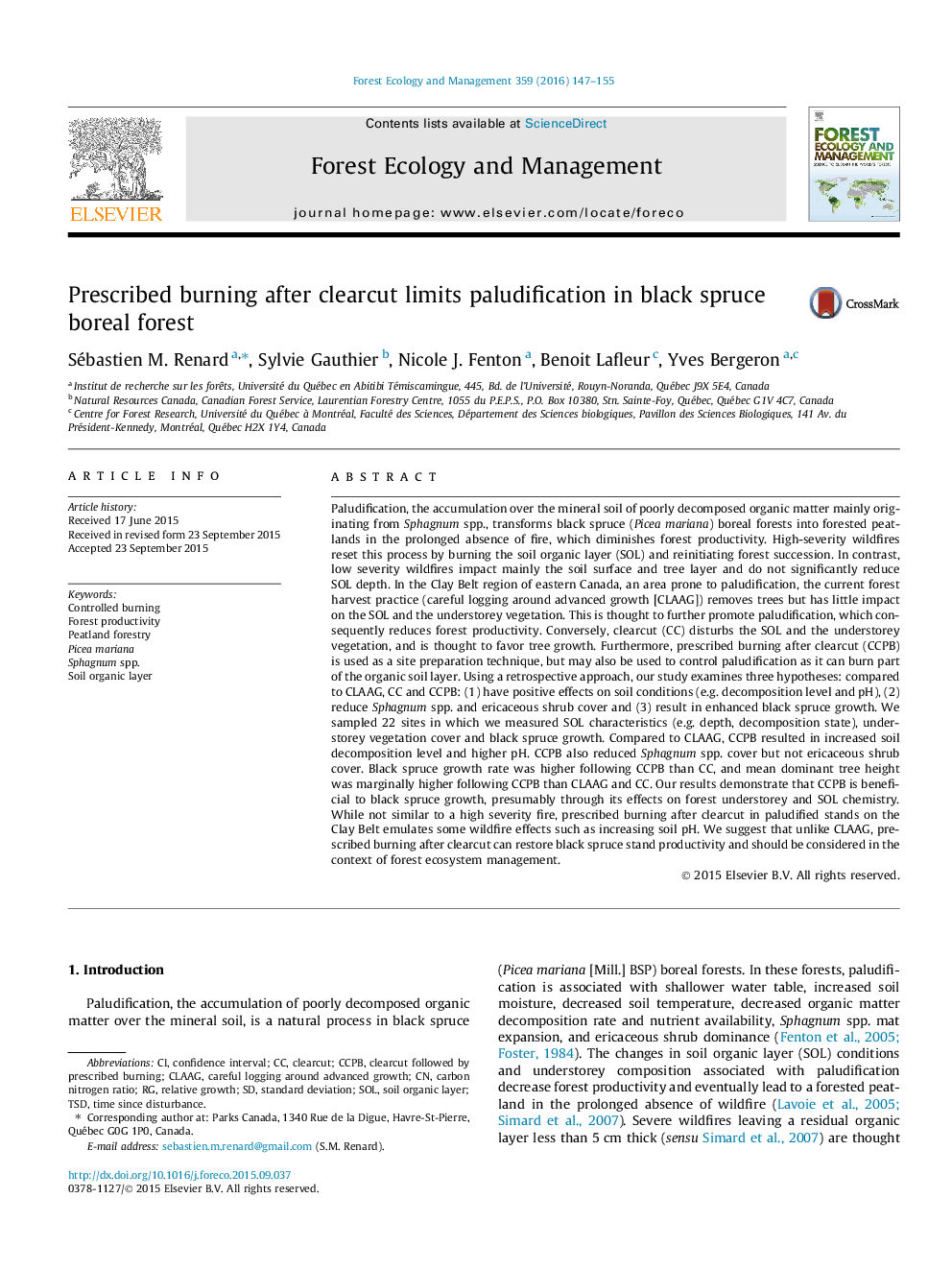| کد مقاله | کد نشریه | سال انتشار | مقاله انگلیسی | نسخه تمام متن |
|---|---|---|---|---|
| 6542648 | 159164 | 2016 | 9 صفحه PDF | دانلود رایگان |
عنوان انگلیسی مقاله ISI
Prescribed burning after clearcut limits paludification in black spruce boreal forest
ترجمه فارسی عنوان
سوزاندن پیشنهادی بعد از برش، محدود کردن پوسیدگی در جنگل های بکر درخت سیاه است
دانلود مقاله + سفارش ترجمه
دانلود مقاله ISI انگلیسی
رایگان برای ایرانیان
کلمات کلیدی
موضوعات مرتبط
علوم زیستی و بیوفناوری
علوم کشاورزی و بیولوژیک
بوم شناسی، تکامل، رفتار و سامانه شناسی
چکیده انگلیسی
Paludification, the accumulation over the mineral soil of poorly decomposed organic matter mainly originating from Sphagnum spp., transforms black spruce (Picea mariana) boreal forests into forested peatlands in the prolonged absence of fire, which diminishes forest productivity. High-severity wildfires reset this process by burning the soil organic layer (SOL) and reinitiating forest succession. In contrast, low severity wildfires impact mainly the soil surface and tree layer and do not significantly reduce SOL depth. In the Clay Belt region of eastern Canada, an area prone to paludification, the current forest harvest practice (careful logging around advanced growth [CLAAG]) removes trees but has little impact on the SOL and the understorey vegetation. This is thought to further promote paludification, which consequently reduces forest productivity. Conversely, clearcut (CC) disturbs the SOL and the understorey vegetation, and is thought to favor tree growth. Furthermore, prescribed burning after clearcut (CCPB) is used as a site preparation technique, but may also be used to control paludification as it can burn part of the organic soil layer. Using a retrospective approach, our study examines three hypotheses: compared to CLAAG, CC and CCPB: (1) have positive effects on soil conditions (e.g. decomposition level and pH), (2) reduce Sphagnum spp. and ericaceous shrub cover and (3) result in enhanced black spruce growth. We sampled 22 sites in which we measured SOL characteristics (e.g. depth, decomposition state), understorey vegetation cover and black spruce growth. Compared to CLAAG, CCPB resulted in increased soil decomposition level and higher pH. CCPB also reduced Sphagnum spp. cover but not ericaceous shrub cover. Black spruce growth rate was higher following CCPB than CC, and mean dominant tree height was marginally higher following CCPB than CLAAG and CC. Our results demonstrate that CCPB is beneficial to black spruce growth, presumably through its effects on forest understorey and SOL chemistry. While not similar to a high severity fire, prescribed burning after clearcut in paludified stands on the Clay Belt emulates some wildfire effects such as increasing soil pH. We suggest that unlike CLAAG, prescribed burning after clearcut can restore black spruce stand productivity and should be considered in the context of forest ecosystem management.
ناشر
Database: Elsevier - ScienceDirect (ساینس دایرکت)
Journal: Forest Ecology and Management - Volume 359, 1 January 2016, Pages 147-155
Journal: Forest Ecology and Management - Volume 359, 1 January 2016, Pages 147-155
نویسندگان
Sébastien M. Renard, Sylvie Gauthier, Nicole J. Fenton, Benoit Lafleur, Yves Bergeron,
